Elizabeth Andrews's Blog, page 21
July 12, 2014
The power of Marigolds
 The Marigold is a powerful aphrodisiac and if eaten has the power to make you see faeries and possibly open a portal into faerie land.It is a well known symbol for good luck and constancy in love and was used in wedding bouquets and love potions.In the west the plant is known as the drunkards due to its reputation for turning people into alcoholics when the flowers are picked. It has a variety of names including husbandsman's dial,marybud, merrygold and summer bride.The Welsh believe that the flower could be used as a weather omen: if the flowers are not open in the morning it means rain is on the way.Hanging a garland of marigolds over your doorway will stop evil from entering your home as it will strip a witch of her free will. If you scatter some petals under your pillows your dreams will come true.
The Marigold is a powerful aphrodisiac and if eaten has the power to make you see faeries and possibly open a portal into faerie land.It is a well known symbol for good luck and constancy in love and was used in wedding bouquets and love potions.In the west the plant is known as the drunkards due to its reputation for turning people into alcoholics when the flowers are picked. It has a variety of names including husbandsman's dial,marybud, merrygold and summer bride.The Welsh believe that the flower could be used as a weather omen: if the flowers are not open in the morning it means rain is on the way.Hanging a garland of marigolds over your doorway will stop evil from entering your home as it will strip a witch of her free will. If you scatter some petals under your pillows your dreams will come true.Faerie Flora, 2013available from Amazon or www.magic-myth-legend.co.uk
Published on July 12, 2014 01:56
July 10, 2014
Slugs and snails
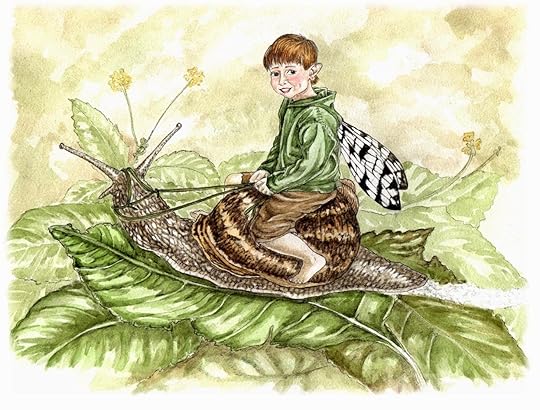
I know that slugs and snails play a vital part in the cycle of nature but why do they have to do it in my garden? Why can't they just move somewhere else, I swear they are the kamakaze variety and just home in on my veg plants.Oh well, here are a few interesting snippets about snails.
Here are a few traditional remedies using snails, I wouldn't really recommend them tho'!
To cure cold sores; rub a snail over the sore then seal the snail in a bottle and bury it in the garden. As the snail dies the sore will fade away.
To cure a hangover; rub a snail nine times over your forehead and then throw the snail as far as possible.
To cure a wart; take a black snail, rub it over the wart nine times in two directions. The snail should then be impaled upon a blackthorn, as it dies the wart will disappear.
In Cornwall snails were regarded as a lucky charm, especially ones with a striped shell, The shell would be thrown backwards over the finder's head while chanting:
'Lucky snail, lucky snail, go over my head
And bring me a penny before I go to bed.'
Extracts from 'Faerie Flora'
Published on July 10, 2014 02:43
July 8, 2014
Somerset Folklore

Somerset Folklore
Somerset, a county rich in folklore, previously called the Summer Lands due to its verdant green pastures, and which has its fair share of strange creatures. From the Oak Men who haunt the woods and the Giant Worm of Shervage Wood, to the more familiar witches, hobgoblins, faeries and pixies. Although pixies are more often associated with Cornwall, it was always understood by residents of this county that everywhere west of the River Parret was pixie land. According to local folklore, Buckland St Mary is the last place where a small race of red clad faeries were seen; they were defeated in battle by the pixies and fled, some to Devon and Dorset and a few making their way to Ireland.

When faeries are mentioned most people think of Disney’s Tinkerbell, a sweet winged creature. But if you had said ‘faerie,’ even a hundred years ago, the reaction would have been very different; country people had a healthy fear and respect for these creatures, believing them to be responsible for many instances of bad luck or illness in their everyday life. The little people had to treated with respect and appeased with offerings of cream and bread to avoid their anger. Many farmers would leave offerings outside their barns in the hope that the pixies would finish the threshing or help with the harvest. This practice was carried on inside the house as well; hearths would be swept and cleared every night so that the faeries could dance in the fireplace and bowls of fresh water left out for them to bathe in. Woe betide the housewife or servant that forgot, for mischief would follow. Interaction was to be avoided for fear of angering them, one well known encounter ended badly for the mortal as a 17th century account reports.Riding across the Blackdown Hills a man stumbled across a faerie market when travelling back to his home at Combe St Nicholas. On the side of the hill was gathered a large number of small brightly garbed people, and he could see peddlers with trays of ribbons and trinkets wandering amongst the tents and crowds. As he drew nearer the figures began to fade but as he passed through the invisible throng he felt himself being pushed and pinched. Quickly leaving the fairground he could see the figures reappearing behind him, and began to experience pain where he had been touched by the invisible hands. By the time he had reached home a strange paralysis had afflicted him down one side, and this,coupled with the pain, continued for the rest of his life. This particular market has been seen several times over the years but none venture too close as the faeries do not welcome guests to this event. Although some intrepid souls thought nothing of the danger in the quest for buried treasure for beneath the many hills of Somerset was believed to be hoards of faerie gold. Cadbury Hill, thought to be Arthur’s Camelot, was once home to faeries before they were driven away by the sound of the newly erected church bells nearby. Here they stored grain which they had gathered from the surrounding plain. They left so quickly that they didn’t have time to remove the gold from the hidden passageways beneath the mound. A well known rhyme tells of the immense wealth hidden beneath the hill:
‘If Cadbury and Dolbury dolven wereAll England would have a golden share.
Cadbury’s treasure is impossible to retrieve however as the harder it is dug for, the farther it sinks into the earth of the hill.Other such sites include Rugborough Camp, Broomfield, and Castle Neroche. Here the treasure seekers fled in fear and empty handed after hearing strange noises and ghostly voices, but not soon enough for within a month each of the men were dead.

Parents especially would be concerned about faeries, fearing that their un-baptized babies would be snatched and a changeling left in their place.One Somerset old wives tale is that you should never dress your child in green until after the christening, as green is the faeries favourite colour and it would enable them to steal the infant.So for protection, an open pair of scissors would be hung over the cot, as faeries cannot bear iron, or an iron pin would be stuck into the baby’s clothes. Holy water would also be sprinkled over the child and the cot.
No discussion of the folklore of Somerset can omit Glastonbury, the sacred isle of Avalon, and supposedly the last resting place of King Arthur. Here on the Tor is said to be the entrance toFaerieland, known as Annwyn, guarded by the Faerie King himself, Gwyn Ap Nudd. His crystal realm is the meeting place of the dead, and it is from here on Samhain (31st October), that he leads the Wild Hunt out across the Somerset countryside.
Now you might think that this is all gone and forgotten but some traditions still prevail; the wassailing of the apple trees during the winter months is still as prevalent today as ever. Offerings of toast dipped in cider are left in the branches of the oldest tree in the orchard to honour ‘The Apple Tree Man’ who is the guardian of orchards. Cider is drunk from the wassailing bowl and if any remains, it is poured over the roots of the tree.
‘Old Apple Tree we wassail thee, and happily thou wilt bear,For the Lord knows where we shall be,Till apples another year.’
To ensure future crops the last few apples must be left for the ‘The Apple Tree Man’ and the pixies.Another traditional festivity that is seeing a come back in the Somerset villages of Chiselborough, Long Sutton, Lopen, Castle Neroche, and Hinton St George is the Punkey night which is held on the last Thursday in October. Punky night is closely linked with Samhain and has similarities with Halloween but the punkey lanterns are carved using mangel wurzels or turnips. The children of the village carry the lanterns around the houses, led by the Punkey King and Queen, singing the traditional punkey song while begging for pennies.
‘It’s Punkey night tonight,It’s Punkey night tonight,Give us a candle, give us a light,It’s Punkey night tonight.
Give me candle Give me a lightIf you don’t you’ll get a fright!
If you haven’t a candleA penny’s alright’
'Faeries and Folklore of the British Isles'
Published on July 08, 2014 07:20
July 7, 2014
Not just a frog...

Faeries often disguise themselves as toads, frogs or even mice, which can be dangerous as frogs and toads especially are often used in magic spells or cures.

The bones of a green frog, the flesh having been consumed by ants are thrown into fresh water. Some will sink and some will float. Take the bones that sink, hang them up in a fresh linen cloth. These will bring love but beware if touched they will bring hate.
This is taken from The Discovery of Witchcraft written in 1584
Frogs are also used to cure thrush: take a living frog and hold it in a cloth, put the head of the frog into the patients mouth making sure that it does not go down the throat. Hold it there until the frog is dead and then take another frog and do the same.
 For a child that wets the bed, roast a mouse and give him the gravy to drink, and it will cure it or for small pox eat a fried mouse.
For a child that wets the bed, roast a mouse and give him the gravy to drink, and it will cure it or for small pox eat a fried mouse.These are traditional cures from the fifteenth and sixteenth centuries so I am not advising that you should try them! And if they were really faeries in disguise I think they would be a little bit annoyed and remember never piss off a faerie!
Published on July 07, 2014 08:30
May 27, 2014
Hampton Court ghosts
[image error]
Last weekend had a splediferous visit to Hampton Court.
What a maze of buildings! got completely lost wandering around, how the courtiers ever found their way I guess we will never know.
I wasn't thinking about ghosts as we wandered around, there was just so much to see!
Walking up one of the main staircase I had a strange chill feeling that I was not alone on the stairs and immediately thought of all the people who had passed that way. I had the same feeling while walking through the rooms used by Wolsey; surrounded by tourists it is rather difficult to try and stop to communicate with any spirits that might be present!
So I thought I would google it when we returned home:
I came across this
Yet this is what happened two years ago on a hot August weekend in Hampton Court Palace. The photographer, Trevor Tye was standing in the main public entrance waiting 45 minutes for the area to clear of tourists before he took this shot looking from the entrance to a galleried area above, in an area devoid of any people.
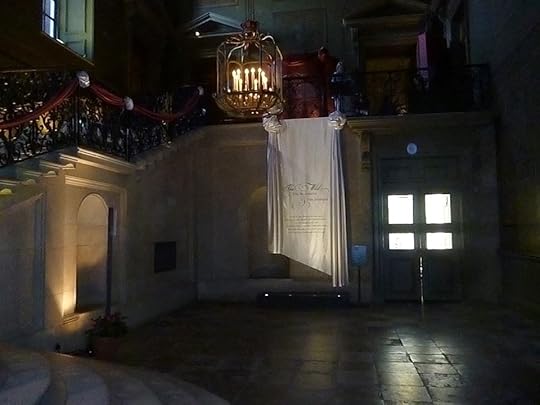
The second image is lightened so you can see clearly
And yes this was the staircase that I walked up and felt a presence.
And there are many more accounts of ghostly presence in and around these old buildings
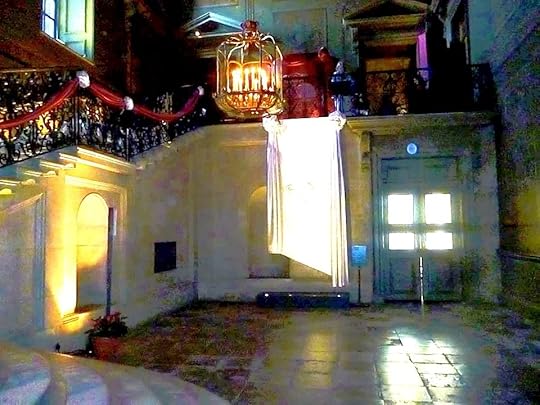
It seems Henry still lingers in his palace, this image was caught on CCTV and spotted by security guards.
One would imagine that he was such a strong personality in life that he can't let go of his mortal life or perhaps he is plagued by guilt and can't rest, hmm I wonder.
Still Hampton Court is well worth a visit and if you're lucky or unlucky depending on your point of view you may spot Henry!
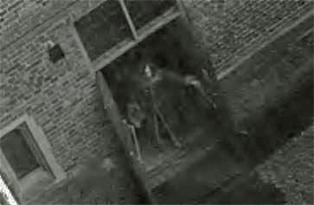
Last weekend had a splediferous visit to Hampton Court.
What a maze of buildings! got completely lost wandering around, how the courtiers ever found their way I guess we will never know.
I wasn't thinking about ghosts as we wandered around, there was just so much to see!
Walking up one of the main staircase I had a strange chill feeling that I was not alone on the stairs and immediately thought of all the people who had passed that way. I had the same feeling while walking through the rooms used by Wolsey; surrounded by tourists it is rather difficult to try and stop to communicate with any spirits that might be present!
So I thought I would google it when we returned home:
I came across this
Yet this is what happened two years ago on a hot August weekend in Hampton Court Palace. The photographer, Trevor Tye was standing in the main public entrance waiting 45 minutes for the area to clear of tourists before he took this shot looking from the entrance to a galleried area above, in an area devoid of any people.

The second image is lightened so you can see clearly
And yes this was the staircase that I walked up and felt a presence.
And there are many more accounts of ghostly presence in and around these old buildings

It seems Henry still lingers in his palace, this image was caught on CCTV and spotted by security guards.
One would imagine that he was such a strong personality in life that he can't let go of his mortal life or perhaps he is plagued by guilt and can't rest, hmm I wonder.
Still Hampton Court is well worth a visit and if you're lucky or unlucky depending on your point of view you may spot Henry!

Published on May 27, 2014 05:41
May 4, 2014
Vodyanoy, a water spirit
 A strange creature from Slavic mythology is the Vodyanoy, a water spirit that appears as a naked old man.
A strange creature from Slavic mythology is the Vodyanoy, a water spirit that appears as a naked old man.He has a frog like face, long greenish beard and hair, his body which is covered in black fish scales, is usually covered in the muck and slime from the bottom of the river. The vodyanoy has webbed paws, a fish’s tail and red eyes. He patrols up and down his stretch of the river on a half submerged log and is often referred to as ‘grandfather’ or ‘forefather’ by the locals.
If annoyed, he is capable of breaking dams, destroying mills
and will drag people and animals down into the depths of the river where they serve him for the rest of their lives.
To appease him, people who live alongside the river will throw offerings into the water; fishermen will also ask for his help by placing a pinch of tobacco in the water and saying:
‘Here’s your tobacco Lord Vodnik
Now give me a fish’
Known as Vodnik in other eastern European countries, his appearance is reported to be different. He appears to be human except for having gills and webbed finger and his hair and skin is green. These vodyanoy usually appear dressed, albeit as a tramp, complete with hat, usually a boater with long speckled ribbons. His face is covered with a long tangled beard.
These water spirits will sit for hours by the side of the river, puffing out clouds of tobacco smoke from a long curly pipe, or if more than one is present they will play cards. Although they can stay out of the water for long periods they never dry out and any garment they wear will be constantly dripping; a sure sign of a Vodyanoy if you should ever meet one.
They store the souls of the drowned in porcelein jars which are greatly prized by these creatures, as the more cups they own the higher standing they have amongst other vodyanoy.
If the jar should be broken or the lid opened the soul inside will float to the surface of the water and be liberated.
Folklore of Mermaids: Elizabeth Andrews
Published on May 04, 2014 02:59
April 6, 2014
When I was just a child....
I grew up in the Dorset countryside, and it was country! Frequently snowed in in the winter, had to travel miles to get to school and the shops and very rarely saw school friends at weekends or during the summer holidays. So this meant having a lot of time to daydream and make believe while playing in the woods and streams.My family tell me that I had an invisible friend for years, little did they know that it was a faerie! So having such a vivid imagination, and still have, I have started to write and illustrate a series of children's books based around the farm where I grew up, 'The Mice of Horsehill Farm.'They have a series of adventures throughout the year in and around the farm, I would like to say that they are not all good and sweet! which, ahem, very much reflects my own childhood!
"Deep in a small wooded valley lies an
old farm. A small bubbling stream
flows past the old buildings, it's banks are
lined with young hazel and willow trees
and in the summer the farm is surrounded
by a sea of flowers and wild garlic.
Spillers, Teasel and their five children live
in the crumbling stone barn. In the winter
they hollow out rooms deep in the hay
where they stay snug and warm, and in the
spring when the barn is empty of hay the
family move up to the top of the stone
walls where it is cool and airy."
 This is their home on top of the barns stone wall.
This is their home on top of the barns stone wall.
Their adventures so far have included naughty squirells, grumpy brownies, faeries and lost dragons.These are going to be published in a series, three so far, some time this year.
One of my children's stories which is already out there is The Faeries Tea Party.
 " Granny was good at telling stories, Chloe would cuddle up
" Granny was good at telling stories, Chloe would cuddle up
next to her on the big old squashy sofa and listen to
wonderful bedtime tales about the faeries, goblins and
monsters that lived in the big wood at the end of the garden.
Granny had just finished a really good story about a giant who
ate six faeries every day for breakfast when Chloe asked her
' Do you really believe in faeries granny?'
Granny smiled down at her.
'Of course I do, because I know that the faeries visit my
kitchen every night. That's why I always leave a little drop of
tea in my cup. They like tea.' She pointed to her favourite
blue and white cup on the table in front of the sofa.
'See?' "
'The Faeries Tea Party' is available on my website www.magic-myth-legend.co.uk and Amazon
"Deep in a small wooded valley lies an
old farm. A small bubbling stream
flows past the old buildings, it's banks are
lined with young hazel and willow trees
and in the summer the farm is surrounded
by a sea of flowers and wild garlic.
Spillers, Teasel and their five children live
in the crumbling stone barn. In the winter
they hollow out rooms deep in the hay
where they stay snug and warm, and in the
spring when the barn is empty of hay the
family move up to the top of the stone
walls where it is cool and airy."
 This is their home on top of the barns stone wall.
This is their home on top of the barns stone wall.Their adventures so far have included naughty squirells, grumpy brownies, faeries and lost dragons.These are going to be published in a series, three so far, some time this year.
One of my children's stories which is already out there is The Faeries Tea Party.
 " Granny was good at telling stories, Chloe would cuddle up
" Granny was good at telling stories, Chloe would cuddle upnext to her on the big old squashy sofa and listen to
wonderful bedtime tales about the faeries, goblins and
monsters that lived in the big wood at the end of the garden.
Granny had just finished a really good story about a giant who
ate six faeries every day for breakfast when Chloe asked her
' Do you really believe in faeries granny?'
Granny smiled down at her.
'Of course I do, because I know that the faeries visit my
kitchen every night. That's why I always leave a little drop of
tea in my cup. They like tea.' She pointed to her favourite
blue and white cup on the table in front of the sofa.
'See?' "
'The Faeries Tea Party' is available on my website www.magic-myth-legend.co.uk and Amazon
Published on April 06, 2014 04:24
March 4, 2014
Kindred Spirit review
Many thanks to the team at Kindred Spirit magazine for such a great review!


"In her charming new book, Elizabeth Andrews writes about, and sketches, the flowers and plants linked to the faeries of our land; here we give you an exclusive glimpse into the springtime world of the magical bluebell and the potent cowslip...."


"In her charming new book, Elizabeth Andrews writes about, and sketches, the flowers and plants linked to the faeries of our land; here we give you an exclusive glimpse into the springtime world of the magical bluebell and the potent cowslip...."
Published on March 04, 2014 06:06
March 2, 2014
Witches Spittle
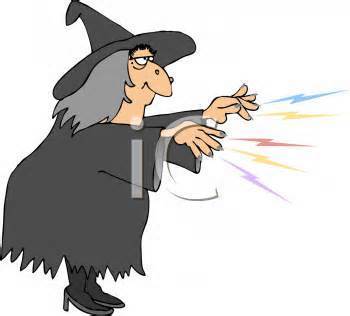
The use of spittle by witches for curing warts is quite well known and was and is used freely in many healing charms , as well as curses.They believed that spittle contained the essence of their personality, and so by spitting on a certain area their power and their influence is brought to bear on that particular spot.Christ cured a man's blindness by spitting into his eyes and it was also common practice in many ancient religious ceremonies, believing that the saliva of the gods bestowed healingOne author of folklore, Ruth St Leger-Gordon recounts a tale from the mid 60's of a neighbour who was well known to be a witch. This woman, Mary Ann, cursed a tradesman with whom she had fallen out by spitting on his doorstep three time and muttering " Take that, take that, take that".After which the man had nothing bad luck, his wife died, his business failed, he then went deaf and to cap it all died young. Her powers, it seemed, could be either black or white depending on her mood; for about the same time she cured a six year old girl of a chronic eye infection which up till then had the local doctor baffled. Mary Ann drew the young girl to one side and spat three times into each eye. The mother, a firm believer in Mary Ann's powers forbade the young girl to wipe the spittle from her face. She was not disappointed for shortly after the young girls eye complaint cleared up and she was able to attend school again.
Many people find that they have the gift for using healing charms without having to be a 'witch' but custom decrees that these gifts must be handed down alternately from man to woman in each succeeding generation. If there is no one suitable in the family then the gift is passed on to an outsider.
Published on March 02, 2014 09:19
February 21, 2014
water, water, water every where!
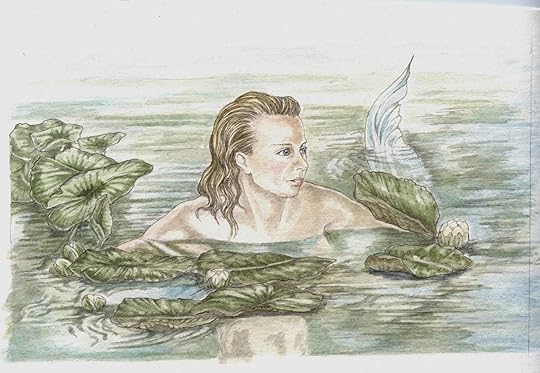
My thoughts are running on water at the moment, I am in the middle of my new book ' The folklore of Mermaids', 90 pages in and still going full steam. It is usually about the 150 page mark that I start to flag!
With all this water about you would have thought somebody would have seen a mermaid but no.. the nearest is the crocodile that was reported near Bristol by a bus driver, he still maintains he saw it and who is to say he was wrong. Strange things get flushed down the drains!
Water has always been venerated, except when it's coming in the front door, take well dressing for example. This is a survival of well worship, the waters were either considered to be prophetic or a cure for ills. Well dressing usually occurs at Ascension tide, this has survived in several places. panels of elaborate pictures of saints were erected around the well. Now it is more common to find the wells decorated with ribbons and flowers asking for wishes to be granted or for cures for illnesses. The association of well worship and tree worship was very close, it was common to find single trees close to the wells and it was upon these that the offering were often placed.
A well worship ceremony was held in Tissington as far back as 1350 in thanksgiving for the peoples' escape from the Black Death. Half of Derbyshire died from this disease but Tissington escaped; this was ascribed to the purity of the water in its five wells.
Near Brampton in Northampton shire, Marvel - sike Springs was considered to be able to predict death or trouble by running in great gluts of water. This spring only ran at times of trouble or evil.
The Drumming Well situated in the same county, gave out a loud drumming noise before any important happening, it was heard before the Scots came to England in the Civil War and again just before Charles II died.
It is still common practice to drop coins into wells and make a wish, crooked pins are dropped into some wells as offering to the lady of the well. The pin was considered to be a very appropriate offering, as it was connected to the donors clothes but it was also made of iron.
Sometimes the guardian of these wells takes on the form of a mermaid or meremaid, yes I have got back to the subject of mermaids! These are often more malicious than the sea going creatures and can cause a lot of trouble in their pools and surrounding areas.
At Childs Ercall some workmen were enticed into the water when a meremaid offered them gold, they only escaped when one of the men used an oath when he saw the size of the lump of gold the meremaid was holding. Lucky for them for undoubtedly they would have met a nasty end!
Published on February 21, 2014 01:29



